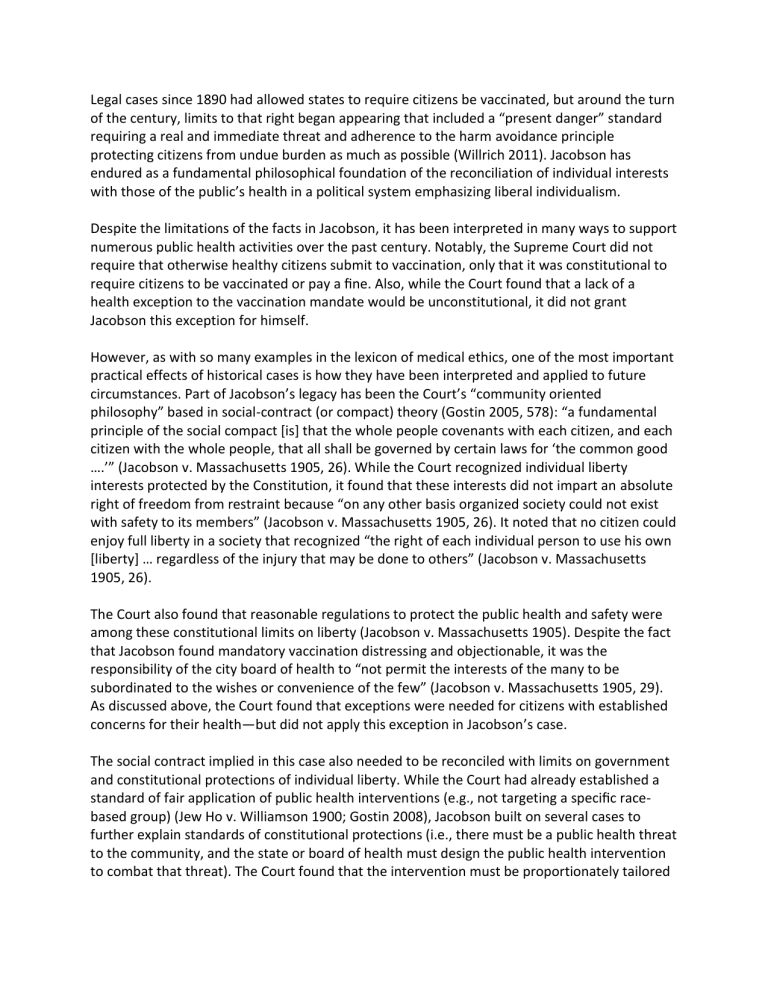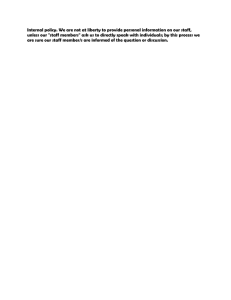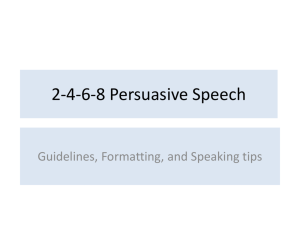
Legal cases since 1890 had allowed states to require citizens be vaccinated, but around the turn of the century, limits to that right began appearing that included a “present danger” standard requiring a real and immediate threat and adherence to the harm avoidance principle protecting citizens from undue burden as much as possible (Willrich 2011). Jacobson has endured as a fundamental philosophical foundation of the reconciliation of individual interests with those of the public’s health in a political system emphasizing liberal individualism. Despite the limitations of the facts in Jacobson, it has been interpreted in many ways to support numerous public health activities over the past century. Notably, the Supreme Court did not require that otherwise healthy citizens submit to vaccination, only that it was constitutional to require citizens to be vaccinated or pay a fine. Also, while the Court found that a lack of a health exception to the vaccination mandate would be unconstitutional, it did not grant Jacobson this exception for himself. However, as with so many examples in the lexicon of medical ethics, one of the most important practical effects of historical cases is how they have been interpreted and applied to future circumstances. Part of Jacobson’s legacy has been the Court’s “community oriented philosophy” based in social-contract (or compact) theory (Gostin 2005, 578): “a fundamental principle of the social compact [is] that the whole people covenants with each citizen, and each citizen with the whole people, that all shall be governed by certain laws for ‘the common good ….’” (Jacobson v. Massachusetts 1905, 26). While the Court recognized individual liberty interests protected by the Constitution, it found that these interests did not impart an absolute right of freedom from restraint because “on any other basis organized society could not exist with safety to its members” (Jacobson v. Massachusetts 1905, 26). It noted that no citizen could enjoy full liberty in a society that recognized “the right of each individual person to use his own [liberty] … regardless of the injury that may be done to others” (Jacobson v. Massachusetts 1905, 26). The Court also found that reasonable regulations to protect the public health and safety were among these constitutional limits on liberty (Jacobson v. Massachusetts 1905). Despite the fact that Jacobson found mandatory vaccination distressing and objectionable, it was the responsibility of the city board of health to “not permit the interests of the many to be subordinated to the wishes or convenience of the few” (Jacobson v. Massachusetts 1905, 29). As discussed above, the Court found that exceptions were needed for citizens with established concerns for their health—but did not apply this exception in Jacobson’s case. The social contract implied in this case also needed to be reconciled with limits on government and constitutional protections of individual liberty. While the Court had already established a standard of fair application of public health interventions (e.g., not targeting a specific racebased group) (Jew Ho v. Williamson 1900; Gostin 2008), Jacobson built on several cases to further explain standards of constitutional protections (i.e., there must be a public health threat to the community, and the state or board of health must design the public health intervention to combat that threat). The Court found that the intervention must be proportionately tailored to that threat creating a “reasonable balance … between the public good and the degree of personal invasion ” and should not harm citizens in and of itself (Gostin 2008, 126–127). While it is hard to reconcile some of the facts of Jacobson with its lofty constitutional deliberation, it is the Court’s desire to reconcile individual interests with those of the public health in a society that values liberal individualism that has become its enduring legacy. Many court decisions following Jacobson reaffirmed states’ use of police power for the public health (Gostin 2005), and in 1922 the Supreme Court agreed that states could require vaccinations for children who attend school (Zucht v. King 1922). Jacobson was an important step in the lengthy public health battle against smallpox, culminating in its eradication in 1977 (Cohen 2000). The legal and ethical boundaries between the individual and public health remain mobile in public health law and policy despite the Jacobson decision. Notwithstanding its rejection of forced vaccination, coercion—as opposed to the modern emphasis on education—continued as a public health tactic, employed frequently and often directed toward vulnerable citizens (e.g., quarantined sex workers during World War I) (Colgrove and Bayer 2005). And despite the liberty protections it carved out, the Court itself struggled with upholding both individual rights and constitutional liberties. In 1927, citing Jacobson, the Court upheld a forced-sterilization law in Virginia of “mental defectives.” The Buck v. Bell decision reasoned that “[i]t is better for all the world, if instead of waiting to execute degenerate offspring for crime, or to let them starve for their imbecility, society can prevent those who are manifestly unfit from continuing their kind. The principle that sustains compulsory vaccination is broad enough to cover cutting the fallopian tubes” (Buck v. Bell 1927, 207). In more communitarian-leaning societies, Jacobson’s value serves less as a map for navigating public good in an individualist context, and more as an illustration of how individual and community interests can be balanced within the political and social structure. Even within the United States, however, Jacobson has been interpreted over the decades to be a foundation for diverse legal opinions supporting remarkable expansions of federal power—including warrantless entry into homes in time-sensitive circumstances of compelling need and a defense of the federal government’s right to detain U.S. citizens without due process as “enemy combatants” (in a dissenting opinion) (Willrich 2011). Many of these cases, and certainly Buck v. Bell serve as a stark reminder that federal powers ostensibly in the public interest cannot be used solely to maximize perceived public benefit—they must be tempered by justice and fairness to both communities and individuals (Lombardo 2008). But as the legal community continued to struggle with what the implications and contours of what Jacobson should be in the United States, officials continued to press on in what was then an unregulated field—that of public health research. One hundred years after Jacobson, neither public health nor constitutional law is the same. Programs essential to today’s public health, such as those that regulate hazardous industries and products and that provide medical care, which would have been struck down in 1905, are routinely upheld today because they serve a legitimate public purpose and do not interfere with personal liberty. In contrast, deprivations of liberty that might have been upheld in 1905 would be struck down today. Public health now has better tools at its disposal: better science, engineering, drugs and vaccines, information, and communication mechanisms for educating the public. The history of US Supreme Court decisions about states’ power to restrict personal liberty shows the different ways in which states’ power can be characterized. At bottom, however, all doctrinal interpretations begin with 1 of 2 presumptions: (1) the state has complete power to do anything that is not expressly prohibited by the federal or its own state constitution, or (2) the state has only those powers granted to it by the people or that constitute an essential aspect of sovereignty for which governments are formed.150,151 Although traces of both views can be seen in the opinions of different justices, the Court has generally adopted the first view: the Constitution provides the only limit on state power. Thus, the Court’s interpretation of what counts as a constitutional right assumes extraordinary importance. As Justice Charles Evans Hughes noted, “We are under a Constitution, but the Constitution is what judges say it is. . . .”152(p199) During the past decade, the Court has been reluctant to recognize constitutional protection for new aspects of liberty. Some scholars and conservative justices have argued that the Due Process Clause does not or should not protect personal liberty, such as the freedom to use contraception, and that states should have freer reign to impose restrictions on people.153–156 Others argued that, without such protection, we might as well not have a Constitution.157Although the Court is not likely to soon abandon what it has already recognized, the renewed debate makes clear how fragile constitutional rights might be. At a time when terrorism threatens the entire world, people may be easily convinced that their security depends upon giving up their liberty. People also may believe laws that restrict personal freedom will not apply to them. History supports the view that coercive laws have largely targeted disadvantaged minorities. Quarantine laws were most often directed at disfavored immigrant groups.39,138During the 19th and early-20th century, people who were poor, nonwhite, or recent immigrants were widely believed to live in filth, intoxication, violence, and debauchery or were often blamed for harboring and spreading disease.158,159 Such attitudes may have surfaced when the Boston Board of Health sent police officers to inoculate “tramps” against smallpox. Police reportedly held some men down and beat others to accomplish their task.160Although we may believe we are more enlightened today, similarly disfavored groups are targets of antiterrorism laws.161 In an era of increasingly limited state funds, there is a danger that legislatures will turn to laws that restrict personal liberty as a substitute for providing the resources necessary for positive public health programs that actually prevent disease and improve health. Such symbolic “grandstanding” may be especially tempting for representatives whose reelection depends more on those who finance their campaigns than on the voters.162 But it shifts responsibility for protecting the public health from the government to individuals and punishes those who are least able to protect themselves. The Bill of Rights was designed to protect individuals against abuses by the state, even when the abuses have the support of the majority. This is why constitutional protection of liberty remains so important. One practical reason for protecting constitutional rights is that it encourages social solidarity. People are more likely to trust officials who protect their personal liberty. Without trust, public officials will not be able to persuade the public to take even the most reasonable precautions during an emergency, which will make a bad situation even worse. The public will support reasonable public health interventions if they trust public health officials to make sensible recommendations that are based on science and where the public is treated as part of the solution instead of the problem. Public health programs that are based on force are a relic of the 19th century; 21st-century public health depends on good science, good communication, and trust in public health officials to tell the truth. In each of these spheres, constitutional rights are the ally rather than the enemy of public health. Preserving the public’s health in the 21st century requires preserving respect for personal liberty. Jacobson v Massachusetts, a 1905 US Supreme Court decision, raised questions about the power of state government to protect the public’s health and the Constitution’s protection of personal liberty. We examined conceptions about state power and personal liberty in Jacobson and later cases that expanded, superseded, or even ignored those ideas. Public health and constitutional law have evolved to better protect both health and human rights. States’ sovereign power to make laws of all kinds has not changed in the past century. What has changed is the Court’s recognition of the importance of individual liberty and how it limits that power. Preserving the public’s health in the 21st century requires preserving respect for personal liberty.



